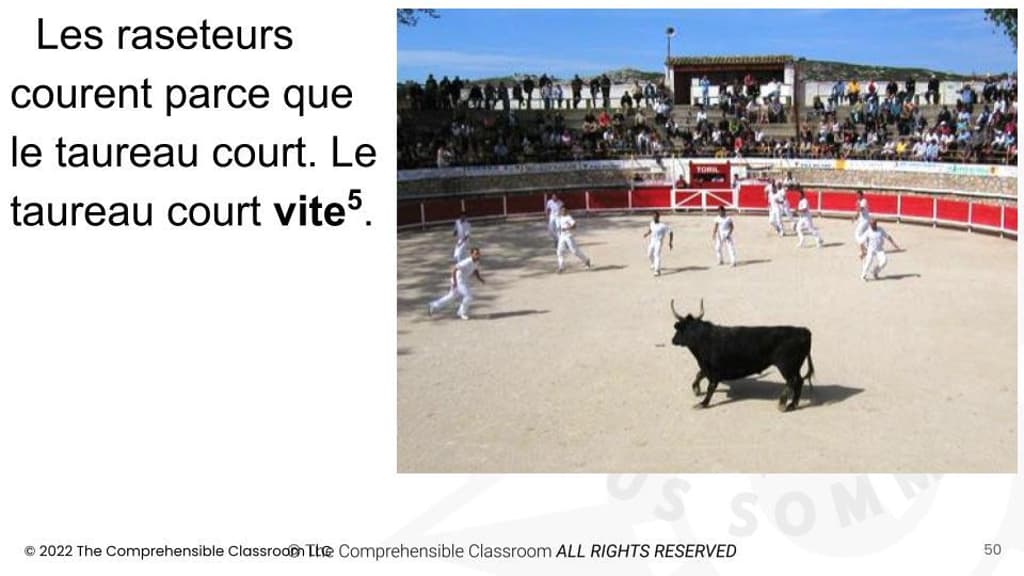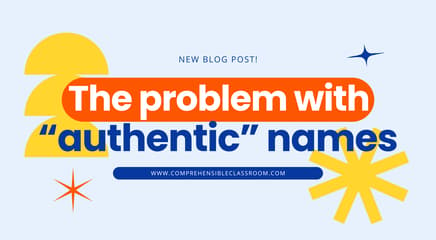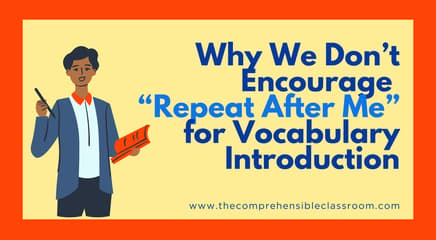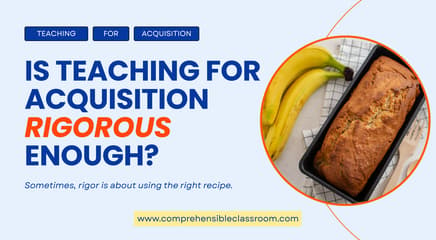Pop-up Grammar is a core strategy used by teachers that have been trained in Acquisition Driven Instruction (ADI) with a focus on making input comprehensible. Whereas grammar has traditionally been a major focus of instruction and therefore instructional minutes in language courses, Pop-Up Grammar flips the traditional, explicit grammar instruction model on its head. Pop-Up Grammar instruction is brief, contextualized, and often unplanned.
Who developed Pop-up Grammar?
As Comprehension-based teaching was developing in the early 2000s, the strategy that we now know as Pop-up grammar was being used and taught by many teachers. However, it did not have a name. One day, Kristy Placido and Carol Gaab found themselves in a Starbucks® discussing their recent interactions with teachers during workshops. At the time, Carol Gaab was President of Fluency Matters, and Kristy was a teacher, trainer, and author. That day, Carol and Kristy were specifically were discussing how to describe their contextualized approach to grammar instruction to other teachers. As the story goes, Kristy said, "It's kind of like those VH1 Pop-up videos, but with grammar!". And, voilà: the name was born.
What is Pop-up Grammar?
Because Pop-up videos were Kristy's inspiration for the name, understanding what a Pop-Up video looks like will help you to wrap your brain around what Pop-up grammar should look like... and why I'll never give it up:
Traditionally, a grammar lesson is its own lesson. What sets Pop-up grammar lessons apart is that they happen DURING a lesson about something else, and they do not break the flow of the lesson. Like VH1's Pop-Up videos, Pop-Up Grammar consists of brief "trivia" or facts about the form of the language that "pop up" while other content is happening and then disappear, never breaking the flow of the content. A viewer could read and process Pop-Up trivia that appear on music videos without taking their attention off the song or the music video, and a student can listen to and process Pop-Up Grammar trivia without taking their attention off the communicative content.
Pop-up Videos were designed to help the viewer learn more about the music video and the artist. The information builds context around the content that ultimately results in the viewer knowing more about it. Pop-up videos are fun and low-stakes: no one is quizzing you on the trivia after the video is over!
Pop-up Grammar is designed to help language learners create links between linguistic forms and their meaning so that learners can better interpret and express messages in a language. Pop-up Grammar is light-hearted and low-stakes. There is no looming assessment after the lesson to make sure students have memorized your Pop-up tidbits.
What Pop-up Grammar isn't
Pop-up Grammar is NOT extended grammar lessons. If you stop working with content (a story, a discussion, an article, etc.) and step away to do a lesson on grammar, it's not Pop-up Grammar. If you are using a worksheet to look at grammar, it's not Pop-up Grammar. There is no such thing as a Pop-up Grammar lesson. Pop-up Grammar is something that happens DURING a lesson about something else.
That's not to say that Acquisition-Focused teachers might use other strategies for Grammar instruction. For example, many teachers are familiar with my Grammar in Context lessons. These lessons are not Pop-up Grammar. Even though the major focus of each lesson is on a text, the whole purpose is for students to look purposely at grammar. It's NOT Pop-up grammar, because the grammar tidbit doesn't "Pop In" and "Pop Out". It's a contextualized grammar lesson, and it's still a grammar lesson.
You are the expert in your classroom, and you know what you need to do to support your students and to meet the requirements of your particular instructional context. By saying that a grammar worksheet is not Pop-up Grammar, I am not saying that you should never use a grammar or vocabulary worksheet. A correct understanding of what Pop-up Grammar is intended to be--and what it is not--can deepen our understanding of Acquisition Driven Instruction and the ways in which these key techniques and strategies are in line with the overall vision.
Pop-up Grammar examples
Perhaps it would help to look at some examples.
The Garbanzo Spanish Podcast
First, let's listen! In Episode 13 of The Garbanzo Spanish podcast, storyteller Camila del Castillo gives a short grammar Pop-up to help listeners understand the connections between several different verb forms, and what the small differences mean.
Although Camila shares this tidbit before the lesson actually begins, this is exactly what Pop-up Grammar could sound like in the middle of the lesson. Let's listen:
Camila says, "You will hear quieres ser (hear that -s on the end?), which means you want to be, and quiero ser (with an -o on the end of quiero), which means I want to be. Quiero, quieres, quiere. Don’t worry, you don’t have to remember all those quieres, but you might notice how in Spanish verbs have different endings that tell you who is doing the action."
Camila could just as easily have said this Pop-up Grammar point after the first time she used "quieres ser" in the text, and related it back to a familiar word for students, which is 'quiere' ser.
Notice how this Pop-up Grammar moment was SHORT, low-stakes (no accountability for learning it), and focused on meaning.
Nous sommes 1 Unit 2
A second example of how you might use Pop-up Grammar comes from Nous sommes 1 Unit 2. In the Connections phase of the unit, the class interprets a Shared Reading about a French bull sports event called La Course Camarguaise.
This slide says: "Les raseteurs courent parce que le taureau court. Le taureau court vite5.", which means "The Course participants run because the bull runs. The bull runs fast".
As you read through this slide with your students, you might point out court and courent and ask students if they could make a guess why there is a difference in the spelling. Some students will likely discern that it's because it's talking about one thing running versus more than one things running. If you'd rather not put the pressure on your students to notice what you want them to notice, you could also lay it out for them: "here, it says courent because more than one raseteurs are running, and here it says court because it's just one bull. The -ent ending means that more than one person is doing the thing, and the -t means that just one person is doing the thing."
...and that's it! Pop-up Grammar is quick and low stakes. It's an easy strategy, and in fact it's probably something that you are already doing in your classes!
Learn more about Pop-up Grammar
This is a trick section. There's really not more to learn! You don't need to attend a workshop on Pop-up Grammar, and you don't need to purchase resources to help you implement it. All you need to do is go communicate with your students, and every once in awhile point out something about grammar to them. Poof! That's it!





